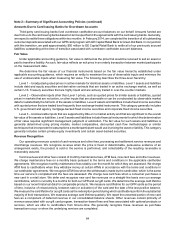Green Dot 2015 Annual Report Download - page 70
Download and view the complete annual report
Please find page 70 of the 2015 Green Dot annual report below. You can navigate through the pages in the report by either clicking on the pages listed below, or by using the keyword search tool below to find specific information within the annual report.64
Note 2—Summary of Significant Accounting Policies (continued)
Amounts Due to Card Issuing Banks for Overdrawn Accounts
Third-party card issuing banks fund overdrawn cardholder account balances on our behalf. Amounts funded are
due from us to the card issuing banks based on terms specified in the agreements with the card issuing banks. Generally,
we expect to settle these obligations within two months. In February 2014, we completed the transition of all outstanding
customer deposits associated with our GPR card program with GE Capital Retail Bank to Green Dot Bank. In conjunction
with this transition, we paid approximately $50 million to GE Capital Retail Bank to settle all of our previously accrued
liabilities outstanding at the time of transition associated with overdrawn cardholder account balances.
Fair Value
Under applicable accounting guidance, fair value is defined as the price that would be received to sell an asset or
paid to transfer a liability. As such, fair value reflects an exit price in an orderly transaction between market participants
on the measurement date.
We determine the fair values of our financial instruments based on the fair value hierarchy established under
applicable accounting guidance, which requires an entity to maximize the use of observable inputs and minimize the
use of unobservable inputs when measuring fair value. The following describes the three-level hierarchy:
Level 1 – Unadjusted quoted prices in active markets for identical assets or liabilities. Level 1 assets and liabilities
include debt and equity securities and derivative contracts that are traded in an active exchange market, as well as
certain U.S. Treasury securities that are highly liquid and are actively traded in over-the-counter markets.
Level 2 – Observable inputs other than Level 1 prices, such as quoted prices for similar assets or liabilities, quoted
prices in markets that are not active, or other inputs that are observable or can be corroborated by observable market
data for substantially the full term of the assets or liabilities. Level 2 assets and liabilities include fixed income securities
with quoted prices that are traded less frequently than exchange-traded instruments. This category generally includes
U.S. government and agency mortgage-backed fixed income securities and corporate fixed income securities.
Level 3 – Unobservable inputs that are supported by little or no market activity and that are significant to the overall
fair value of the assets or liabilities. Level 3 assets and liabilities include financial instruments for which the determination
of fair value requires significant management judgment or estimation. The fair value for such assets and liabilities is
generally determined using pricing models, market comparables, discounted cash flow methodologies or similar
techniques that incorporate the assumptions a market participant would use in pricing the asset or liability. This category
generally includes certain private equity investments and certain asset-backed securities.
Revenue Recognition
Our operating revenues consist of card revenues and other fees, processing and settlement service revenues and
interchange revenues. We recognize revenue when the price is fixed or determinable, persuasive evidence of an
arrangement exists, the product is sold or the service is performed, and collectability of the resulting receivable is
reasonably assured.
Card revenues and other fees consist of monthly maintenance fees, ATM fees, new card fees and other revenues.
We charge maintenance fees on a monthly basis pursuant to the terms and conditions in the applicable cardholder
agreements. We recognize monthly maintenance fees ratably over the month for which they are assessed. We charge
ATM fees to cardholders when they withdraw money at certain ATMs in accordance with the terms and conditions in
our cardholder agreements. We recognize ATM fees when the withdrawal is made by the cardholder, which is the same
time our service is completed and the fees are assessed. We charge new card fees when a consumer purchases a
new card in a retail store. We defer and recognize new card fee revenues on a straight-line basis over our average
card lifetime, which is currently five months for both our GPR and our gift cards. We determine the average card lifetime
based on our recent historical data for comparable products. We measure card lifetime for our GPR cards as the period
of time, inclusive of reload activity, between sale (or activation) of the card and the date of the last positive balance.
We measure the card lifetime for our gift cards as the redemption period during which cardholders perform the substantial
majority of their transactions. We reassess average card lifetime quarterly. We report the unearned portion of new card
fees as a component of deferred revenue in our consolidated balance sheets. Other revenues consist primarily of
revenue associated with our gift card program, transaction-based fees and fees associated with optional products or
services, which we offer to cardholders from time-to-time. We generally recognize these revenues as purchase
transactions occur or when the underlying services are completed.
























